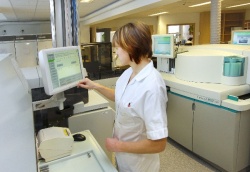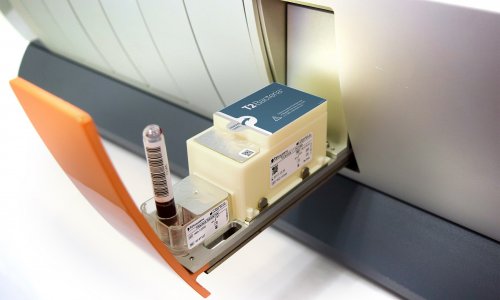The 3rd Annual General Meeting of the Austrian Society for Laboratory Medicine and Clinical Chemistry
Standards in autoimmune diagnostics, pre-analysis mistakes and new tumour and sepsis markers and allergy diagnostics were topics for intense discussion during this year’s meeting in Salzburg, Michael Krassnitzer reports
Different tests bring different results, and results of the same types of test vary from laboratory to laboratory. "In the case of test procedures for autoimmune diseases there are incredible discrepancies," confirmed Professor Manfred Herold, head of the Laboratory for Rheumatism at the University Clinic for Internal Medicine One, Innsbruck. The reason: "There are no standards for the test procedures currently available."


Around 2% of Europe’s population is affected by autoimmune diseases. Some very effective, highly specific treatments are available that can often achieve complete freedom from symptoms for patients. However, treatment needs to begin in time – and this requires quick, clear diagnostics. In the case of rheumatoid arthritis, for example, the process of joint destruction sets in within a few weeks of the onset of the disease. However, quickly obtaining the correct result is not a matter of course. ‘The test results are extremely dependent on the technology,’ the professor pointed out. Thus different laboratories achieve different test results -- even if they work with equipment supplied by the same manufacturer. Likewise, even in the same establishment the same equipment does not necessarily arrive at the same results; a small difference in the brightness of an immunofluorescence lamp for instance is enough to cause discrepancies.
The ANA test, i.e. screening for antinuclear antibodies by examining human epithelial cells (HEp-2 cells) via immunofluorescence, and the ELISA procedure (enzyme-linked immunosorbent assay), which can detect antibodies in the blood serum, often come to completely different results – e.g. in the determination of the Anti-Ro/SSA antibodies, which have an important diagnostic significance for Sjögren’s syndrome or systemic Lupus erythematosus (SLE). ‘It might be that the same sample shows a high positive ANA and a negative ELISA test result. How are we to interpret these results?’
The European Autoimmunity Standardisation Initiative (EASI) aims to unify autoimmune diagnostics in the European Member States, along with producing guidelines on their correct implementation, application and interpretation. ‘This is a delicate balancing act. We are not allowed to advertise the products of certain manufacturers, but are still expected to deliver concrete advice,’ explained Prof. Herold, who also heads the Austrian EASI group. A first step in the right direction is to ascertain the status quo. The Netherlands, Austria and Portugal were the first countries where surveys established which procedures were being used in the different laboratories.
Prof. Herold advised all laboratory operators against a switch to a different, allegedly better test procedure before there are any binding recommendations. ‘There is no “correct” test for any respective clinical picture. It would be best to stick to whatever current procedure is being used,’ he emphasised.
Pre-analysis errors
‘The most common errors in the laboratory happen in pre-analysis. 95% of pre-analytical mistakes occur outside the laboratory,’ said Dr Georg Endler, of the Central Laboratory at the Wilhelminenspital, Vienna. ‘Inaccurate pre-analysis always means inaccurate results: rubbish in – rubbish out,’ he said, during his lecture suggesting ways to reduce such errors.
The wrong patient, lost samples, contamination or inadequate storage are common in pre-analytical errors. ‘Conventional measures for quality assurance do not capture the pre-analytic error sources,’ Dr Endler pointed out, prior to a plea for the determination of transparent acceptance criteria for samples, and communication, in writing, with the senders. Samples with ambiguous patient identification, insufficient labelling and insufficient allocation should be rejected, along with samples of insufficient size, or of the wrong material, as well as samples that have been in transit for too long. The only exception: Samples that cannot be taken again, e.g. smears taken during surgery, fluid or bone marrow. ‘In these cases, results should be established, but with reservations,’ he advised.
A relatively common mistake that can occur in the laboratory itself is contamination with DNA or RNA. For avoidance, Dr Endler recommended a clear definition of responsibilities, unidirectional flow of samples and separate areas for sample retrieval and DNA isolation, implementation of the polymerase chain reaction (PCR), amplification and analysis of the PCR products.
‘Contamination through DNA and RNA must also be avoided at all costs outside the laboratory,’ he emphasised, and recommended the use of DNA- and RNA-free sample tubes. ‘Attention! Sterile does not mean free of DNA,’ he warned, then citing a criminal case in Germany where erroneous laboratory results led the police to chase a phantom for years. DNA traces of an assumed major, female criminal, possibly responsible for murders, burglaries and other crimes across half of Europe, turned out to be contamination through a female employee of the firm that had manufactured the swabs.
A further error source during pre-analysis was mentioned by Professor Stylianos Kapiotis, who heads the Medical Central Laboratory of the Vinzenz Group (a private operator with several hospitals across Austria). New coagulants are increasingly found in samples. ‘Direct anticoagulants – particularly the new oral substances – can have a strong effect on coagulation tests,’ he explained. Quantitatively the results can then only be interpreted with considerable limitations. His strategy to counter this: ‘Blood should be taken just before medication is taken.’
Molecular allergy diagnostics
The comparison is akin to a modern mobile phone and an old dial telephone, said Professor Rudolf Valenta, of the Division of Immunopathology, Department of Pathophysiology and Allergy Research Centre for Pathophysiology, Infectology and Immunology at the Medical University of Vienna, when describing the difference between a conventional skin test and the modern chip test in allergy diagnostics. Molecular allergy diagnostics is far superior to the prick test and other procedures, he pointed out.
Component-resolved diagnostics (CRD) facilitates the precise, quantitative detection of even the smallest concentrations of specific immunoglobulin E-antibodies with the help of micro-arrays. This enables the compilation of a detailed sensitisation profile of a patient, so that the risk of severe allergic reactions can be assessed, and cross reactivity patterns and the patient’s suitability for a specific immune therapy evaluated. Additionally, CRD can be used to monitor treatment progress during immune therapy.
Molecular allergy diagnosis offers enormous advantages, particularly in the case of cross reactions. It answers the question of whether a patient has indeed been sensitised against two or more allergy sources (co-sensitisation), or whether he shows cross sensitisation due to cross reactive allergens. Over the last ten years, a number of molecules have been identified as the main allergy sources. This showed that some allergens are exclusively produced in certain allergy sources and can be used as specific marker allergen components. However, other compounds act as cross reactive marker allergen components in different, not even related, allergy sources, e.g. birch and grass pollen. The existence of IgE antibodies against specific marker allergen components confirms the actual sensitisation against this allergy source. IgE antibodies against cross reactive marker allergen components explain the reaction to different, non-related allergen sources.
To ensure the patient knows exactly which molecule he has a reaction to – and not just which allergy source – is particularly important in allergies against plant-based foods. ‘Being sensitised against apples is not the same as being sensitised against apples,’ Prof. Valenta emphasised. In an apple allergy it makes a big difference whether the patient is sensitised to the Bet v 1-molecule or non-specific lipid transfer proteins. Unlike the main apple allergen, lipid transfer proteins can cause a massive, systemic anaphylactic reaction, he warned.
Precise CRD results also disprove the common misconception that a patient’s allergy reaction pattern changes over the years, as Prof. Valenta explained. ‘If you have an allergy then you can increase your reaction through allergen exposure and decrease it through avoidance of the allergens – but the allergy profile will always remain the same.’
29.12.2010











